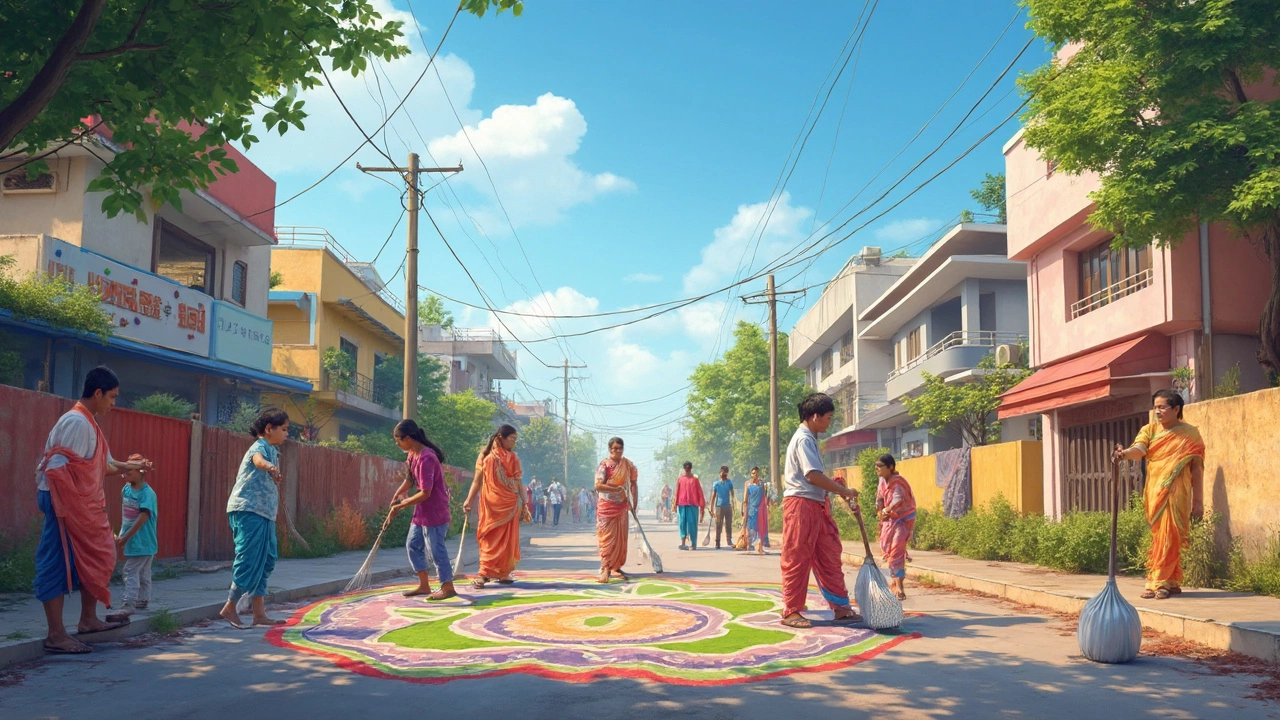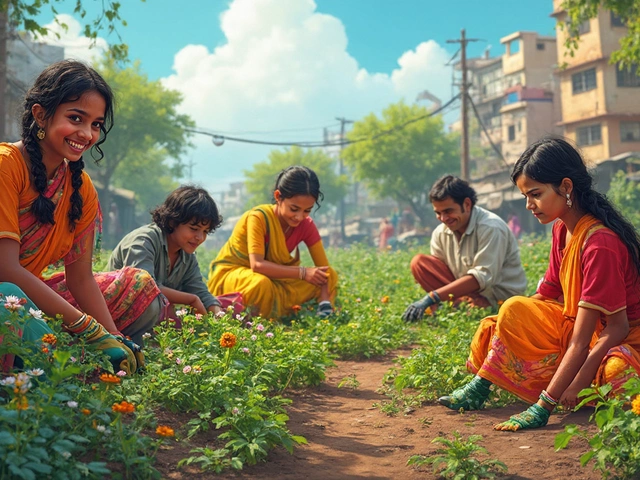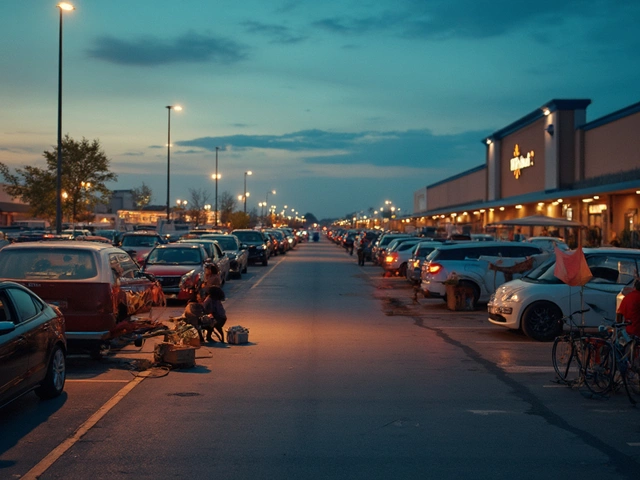Ever wondered how a simple community activity like a cleanup drive can transform not just a neighborhood, but the people in it? It's not just about picking up litter; it's about building bonds. Gathering the locals for a common cause ignites a sense of ownership and care that extends beyond the event itself. Suddenly, that park you're cleaning isn't just a patch of grass—it's a meeting ground, a place for picnics, and a community symbol.
Now, you might be thinking, 'Sounds great, but how do I even start such an activity?' Well, the first step is understanding what a community activity truly entails. It's any initiative that brings people together for a positive change. This could be cleaning up shared spaces, like I mentioned, or setting up a small community garden where everyone gets a little patch to grow their greens. Not only does it beautify the area, but it also encourages sustainability and healthy food habits.
Then there are the skill-sharing workshops where folks teach each other anything from cooking to coding. Imagine exchanging a potluck dinner recipe for a crash course in photography. It's practical, empowering, and, most of all, fun! The trick is to identify what the community needs or is interested in, and it's always amazing to see how eager people are to share their knowledge and skills.
- Understanding Community Activities
- Neighborhood Cleanup Drives
- Community Gardens
- Skill-Sharing Workshops
- Youth Mentorship Programs
- Tips for Getting Involved
Understanding Community Activities
So what exactly is a community activity? At its core, it's about people coming together to address common needs, interests, or goals. These activities are like the building blocks of society, fostering connections and cooperation among residents. It's where people from all walks of life pitch in to make their neighborhood a better place.
Community activities vary widely, but they usually fall into a few categories. Some focus on improving the environment, like organizing a street cleanup or starting a community garden. Others aim to strengthen social bonds, like neighborhood barbecues or potluck dinners. Then there are those that focus on skills and education, such as skill-sharing workshops or mentoring programs.
Why Do They Matter?
These activities might seem small in scope, but they have a massive impact. They help reduce isolation and create a sense of belonging. In a world where we're more digitally connected than ever, face-to-face interaction through these endeavors is crucial. Plus, they often lead to bigger community improvements and inspire civic engagement.
Types of Community Activities
- Environmental Projects: Activities like tree planting or organizing recycling drives to create a cleaner, greener environment.
- Social Events: Festival days, themed movie nights, and cultural celebrations bring people together for fun and friendship.
- Educational Programs: Workshops, tutoring sessions, and skill-building classes help people learn and grow.
Statistical data often highlights the impact of these initiatives. In fact, communities with regular outreach activities report higher levels of happiness and engagement among residents. A study from 2023 showed that people involved in local engagement activities are 60% more likely to participate in future community projects.
Neighborhood Cleanup Drives
Neighborhood cleanup drives are more than just a quick fix for a messy street. They are a fantastic way to increase local engagement and bring people closer together. When a bunch of people show up with garbage bags and gloves, it's like magic how the place starts to change, not to mention the community spirit that comes to life.
Why Cleanup Drives Matter
First off, they're great for the environment. By removing trash, you're not just beautifying a public space. You're protecting local wildlife and reducing pollution. It's a fact that urban areas can see a noticeable drop in litter when regular cleanups are organized. Plus, it directly impacts how the neighborhood looks and feels, often increasing property values.
Planning a Successful Cleanup
Getting started with a cleanup drive doesn't have to be overwhelming. Here are a few practical steps:
- Choose the Location: Pick a spot that needs attention, whether it's a park, beach, or street corner.
- Gather a Team: Rally neighbors, friends, and even local businesses to join in.
- Set a Date: Opt for a weekend morning when more people are free.
- Promote the Event: Use social media or community bulletin boards to get the word out.
- Get Supplies: Stock up on gloves, trash bags, and grabbers. Local stores might sponsor supplies.
- Safety First: Brief everyone about safety precautions and assign tasks based on comfort levels.
Making It Fun
Turn the cleanup into a fun event! Play music, hold contests for the most trash collected, and maybe finish off with a community picnic. Creating a good time is key to keeping the energy high and participation strong.
Here’s a quick look at how effective these drives can be:
| City | Annual Events | Avg Trash Removed (tons) |
|---|---|---|
| Auckland | 15 | 22 |
| Sydney | 20 | 25 |
| Wellington | 12 | 18 |
So, whether you're passionate about the environment, meeting new people, or just want to improve your local area, a neighborhood cleanup is one of the most rewarding activities you can get involved in.
Community Gardens
Community gardens are a brilliant way to bring residents together while encouraging sustainable living. These gardens are typically shared spaces where neighbors plant and maintain a range of vegetables, herbs, and flowers. They're more than just gardens; they're hubs of learning and cooperation. It's about teamwork—neighbors transforming a vacant lot into a lush, productive area.
Dr. Liam Schofield, a well-known horticulturist, once said,
"A community garden is not just about growing food; it's about growing connections, understanding, and a shared vision for a healthier future."
How do you get started with a community garden? Here’s a handy guide:
- Scout a Location: Look for unused land in your area. It could be a vacant lot or space within a community park. Ensure it gets enough sunlight and has access to water.
- Gather Your Team: Rally the locals! Host a meeting to generate interest and form a gardening group. Everyone will bring different skills and ideas, which is exactly what you need.
- Plan Your Garden: Decide what to plant. Think about seasonal vegetables or local flora. Draw up a layout plan considering sun exposure and plant compatibility.
- Get Necessary Approvals: Check with local authorities about permits or regulations you might need to follow. It avoids hiccups once the project gets rolling.
- Start Planting: Organize a community planting day. Not only does it speed things up, but it’s a bustling day full of laughter and cooperation.
Why bother with a community garden? Well, research shows that they can boost property values by nearly 9% in some urban areas. Plus, it's great for mental health—a win-win!
Community gardens also play a crucial role in reducing food deserts. In certain regions, access to fresh produce is limited. By creating these gardens, you're providing people with nutritious options right on their doorstep.
Here’s a quick look at some stats:
| Benefit | Improvement |
|---|---|
| Property Value | Up to 9% |
| Access to Fresh Produce | Immediate |
| Mental Health | Improved Wellbeing |
Ultimately, a community garden represents more than just vegetables and flowers. It seeds community spirit, fosters education, and feeds both body and soul. So grab those gardening gloves and get planting!

Skill-Sharing Workshops
Picture this: a hall buzzing with people trading their unique talents. That's the magic of skill-sharing workshops. They typically gather folks eager to learn or teach new skills, fostering an environment of mutual growth.
So, what's the big deal with these workshops? Well, they're not merely about honing a hobby or picking up a new trick. They play a pivotal role in strengthening community bonds and increasing local engagement. By swapping skills, people build relationships that transcend the workshop room itself. Whether it's learning to bake sourdough bread or mastering basic guitar chords, everyone has something valuable to offer.
How to Start a Skill-Sharing Workshop
Begin by assessing local interests. You might circulate a survey or have casual chats to gauge what people are keen on learning or teaching. Once you have a shortlist, it's time to set the ball rolling by following these simple steps:
- Venue Planning: Secure a community hall, library room, or even someone's spacious backyard. The setting should be comfortable and accessible.
- Promotion: Use social media, community boards, or good old-fashioned word of mouth to spread the word. Clear details about what skills will be shared can pique interest.
- Schedule Sessions: Create a timetable. It's good to have sessions no longer than an hour to keep energy levels high and ensure focus.
- Materials and Tools: Depending on the skills being shared, ensure the necessary tools are available. Encourage participants to bring what they can.
- Feedback: At the end of each session, gather reflections. It helps in understanding what worked and what could be improved.
"Skill-sharing workshops foster deeper connections and a sense of belonging." - Community Leader Emma Sinclair
These workshops are customizable and can be hosted either as one-off events or regular meet-ups. The flexibility makes them accessible to a wide audience, from teens to seniors.
More interestingly, data from the Community Exchange Report (2023) highlights that neighborhoods running regular skill-sharing sessions saw a 20% improvement in local engagement and support networks. It's striking how such grassroots initiatives can nurture an environment where community outreach thrives.
Next time you're feeling like trying something new, why not check out a skill-sharing workshop? Or better yet, organize one. It's a win-win for everyone involved!
Youth Mentorship Programs
Youth mentorship programs are a cornerstone of effective community outreach. These initiatives pair young people with experienced adults who can offer guidance and support. It's not just about giving advice—it's about forming relationships that can last a lifetime.
Mentorship helps bridge the gap between generations. Younger folks gain access to a wealth of experience and wisdom, while mentors get a fresh perspective on today's challenges. Whether it's navigating school, career decisions, or personal growth, having a mentor can be a game-changer.
Getting Started with Mentorship Programs
If you’re thinking about starting or joining a mentorship program, here are some tips to help you hit the ground running:
- Identify the Needs: What are the main challenges young people face in your community? Understanding their needs is the first step in offering relevant support.
- Find the Right Match: Pair mentors and mentees carefully. Shared interests and goals can make the relationship much more effective.
- Set Clear Goals: Both mentors and mentees should agree on what they hope to achieve. Clear objectives keep everyone focused and motivated.
Successful programs often offer structured activities and regular check-ins to keep track of progress. Some programs even use digital platforms to connect mentors and mentees, making participation easier in today's digital age.
The Impact of Mentorship
Studies show that mentored youth are 55% more likely to enroll in college and 78% more likely to volunteer in their communities as adults, showcasing the long-term benefits of these programs. To top it all, many mentors find the experience equally rewarding.
| Mentorship Benefit | Percentage |
|---|---|
| Higher college enrollment | 55% |
| Increased volunteering | 78% |
Inspired yet? Becoming a mentor or setting up a program might just be one of the most impactful ways to contribute to your local engagement efforts.
Tips for Getting Involved
So, you're ready to dive into some community activity but unsure where to start? Don't worry, I've got you covered. The first step is to reach out! This could mean joining local groups on social media or attending community meetings at your local library or town hall. Trust me, there's always a hub of information waiting to be tapped.
Find Your Passion
One way to stick with it is to align your efforts with your interests. Love gardening? Check if there's a community garden nearby. Passionate about education? Look into youth mentorship programs or offer to help at a school event. When you care about the cause, getting involved feels less like a chore and more like an energizing activity.
Start Small
You don’t need to spearhead a massive project right out the gate. Begin with small acts that can grow into something bigger. A great example is organizing a cleanup drive. Gather a few friends, pick a spot, and spend a morning collecting trash. It's straightforward, impactful, and, who knows—it might even inspire others to join your next effort.
"Community activities create a ripple effect of positivity. When people see the change, they want to become part of it." — Dr. Sarah Lee, Community Outreach Expert
Collaborate with Local Organizations
Often, your local non-profits or civic groups are already engaged in outreach. See if you can team up. Your enthusiasm could be exactly what they need for an upcoming event. Plus, it’s a fantastic way to meet like-minded people and learn from those who’ve been in the game longer.
Build Momentum
Once you've had a taste of community engagement, keep the ball rolling. Consistency is key. Maintain an active presence in meetings, or set routine times for involvement. This not only helps in deepening connections but also enhances the local engagement you contribute to.
Useful Data Snapshot
| Activity Type | Estimated Volunteers | Impact |
|---|---|---|
| Neighborhood Cleanup | 10-30 | Immediate Environment Improvement |
| Community Garden | 5-15 | Long-Term Sustainability |
| Skill-Sharing Workshop | 5-20 | Skills Enhancement |
Getting involved in a community activity can be life-changing for both you and those around you. So why not take the step today? With a little effort, you’ll soon become a familiar face in your neighborhood’s outreach scene!








